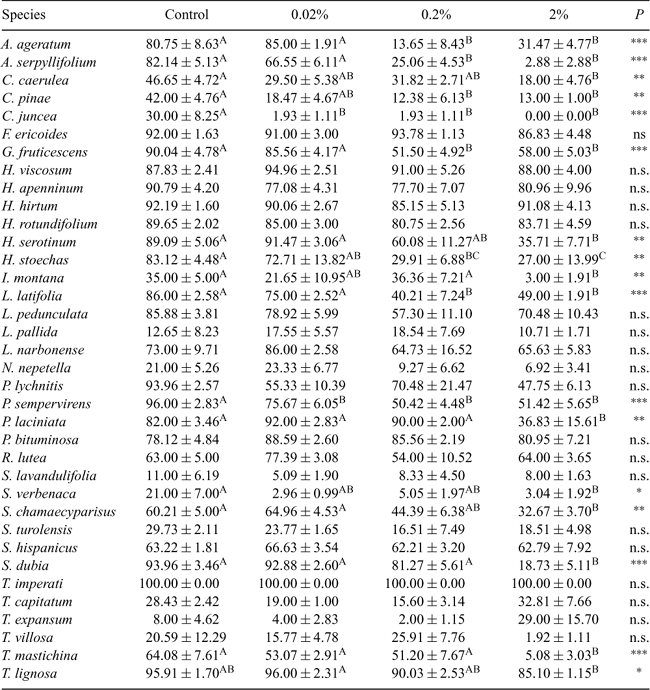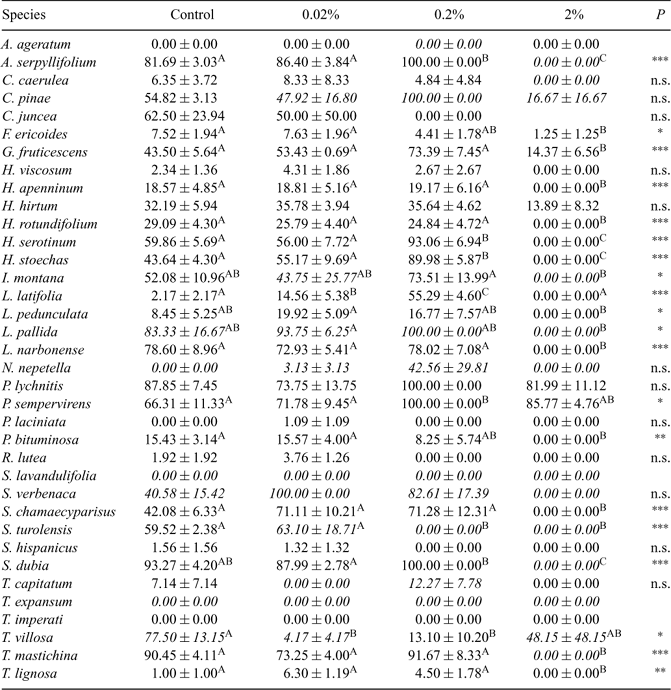Effects of a long-term fire retardant chemical (Fire-Trol 934) on seed viability and germination of plants growing in a burned Mediterranean area
Belén Luna A , José M. Moreno A B , Alberto Cruz A and Federico Fernández-González AA Departamento de Ciencias Ambientales, Facultad de Ciencias del Medio Ambiente Universidad de Castilla-La Mancha, Av. Carlos III s/n, E-45071 Toledo, Spain.
B Corresponding author. Email: JoseM.Moreno@uclm.es
International Journal of Wildland Fire 16(3) 349-359 https://doi.org/10.1071/WF06093
Submitted: 13 June 2006 Accepted: 10 January 2007 Published: 3 July 2007
Abstract
This work documents the effect of a common, long-term fire retardant chemical, Fire-Trol 934, on seed viability and germination of 36 plant species growing in a burned Mediterranean area, covering different life-form types, regenerative strategies and distribution ranges. Seeds were subjected to four treatments: control, and application of Fire-Trol 934 at concentrations of 0.02, 0.2 and 2%. Fire-Trol 934 significantly decreased both seed viability and germination in the group of species studied, which suggests that Fire-Trol 934 may be toxic for seeds, at least when applied at high concentrations. Whereas seed viability generally showed a progressive decrease with increased Fire-Trol 934 concentration, germination percentages generally increased when intermediate Fire-Trol 934 concentrations were used, but tended to be drastically reduced when seeds were exposed to the highest (2%) concentration. The reduction observed in germination at the highest Fire-Trol 934 concentration was greater than that observed in viability, which suggests that the effect of Fire-Trol 934 on seeds may not be lasting. Little differences in the response to Fire-Trol 934 emerged among plant groups, all of which followed the general tendency described above.
Additional keywords: chamaephyte, geographic distribution range, hemicryptophyte, Iberian Peninsula endemics, seeder, sprouter.
Acknowledgements
This study was supported by ERAS project (EVG1–2002–00019). We thank Angel Velasco, Beatriz Sánchez and Mª José Colino for their technical support.
This paper is dedicated to Rubén Cruz, with the hope that when he grows he will appreciate the scientific interests his father had, and would have enjoyed if life had followed its normal course.
Angeler DG, Rodríguez M, Martín S , Moreno JM (2004) Assessment of application-rate dependent effects of a long-term fire retardant chemical (Fire-Trol 934 ®) on Typha domingensis germination. Environment International 30(3), 375–381.
| Crossref | GoogleScholarGoogle Scholar |
Bell DT, Rokich DP, McChesney CJ , Plummer JA (1995) Effects of temperature, light and gibberellic acid on the germination of seeds of 43 species native to Western Australia. Journal of Vegetation Science 6, 797–806.
| Crossref | GoogleScholarGoogle Scholar |
Cruz A, Pérez B, Velasco A , Moreno JM (2003) Variability in seed germination at the interpopulation, intrapopulation and intraindividual levels of the shrub Erica australis in response to fire-related cues. Plant Ecology 169, 93–103.
| Crossref | GoogleScholarGoogle Scholar |
Garland T, Dickerman AW, Janis CM , Jones JA (1993) Phylogenetic analysis of covariance by computer simulation. Systematic Biology 42, 265–292.
| Crossref | GoogleScholarGoogle Scholar |
Hartskeerl K, Simmons D , Adams R (2004) Does firefighting foam affect the growth of some Australian native plants? International Journal of Wildland Fire 13, 335–341.
| Crossref | GoogleScholarGoogle Scholar |
Henig-Sever N, Eshel A , Ne’eman G (1996) pH and osmotic potential of pine ash as post-fire germination inhibitors. Physiologia Plantarum 96, 71–76.
| Crossref | GoogleScholarGoogle Scholar |
Kazanis D , Arianoutsou M (1996) Vegetation composition in a post-fire successional gradient of Pinus halepensis forests in Attica, Greece. International Journal of Wildland Fire 6, 83–91.
| Crossref | GoogleScholarGoogle Scholar |
Quintana JR, Cruz A, Fernández-González F , Moreno JM (2004) Time of germination and establishment success after fire of three obligate seeders in a Mediterranean shrubland of Central Spain. Journal of Biogeography 31, 241–249.
| Crossref | GoogleScholarGoogle Scholar |
Wedin DA , Tilman D (1996) Influence of nitrogen loading and species composition on the carbon balance of grasslands. Science 274, 1720–1723.
| Crossref | GoogleScholarGoogle Scholar |

Wilson SD , Shay JM (1990) Competition, fire, and nutrients in a mixed-grass prairie. Ecology 71, 1959–1967.
| Crossref | GoogleScholarGoogle Scholar |

† A. Cruz passed away on December 15, 2006.




